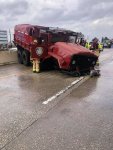Hydroplane ANY tires 12312020.docx
I saved this from 2005, one of my studies……………….
There is only about 20 to 30 square inches of tire on the road at any one time.
It was NASA scientists who discovered that the speed at which dynamic hydroplaning occurs is directly related to tire pressure. In general, tires can hydroplane at any speed that is roughly equal to or greater than nine times the square root of the tire pressure. A light aircraft with tires inflated to 30 pounds per square inch could thus hydroplane at 49 knots or above. A jet with 175-psi tires could hydroplane at 119 knots or higher. It's worth noting that for every two to three pounds of tire under-inflation, your aircraft's minimum hydroplaning speed will decrease about 1 knot.
Tire-tread depth and design greatly affects the likelihood of hydroplaning too. Research has shown that as little as one-tenth of an inch of standing water is all that's needed for dynamic
hydroplaning to occur. The deeper a tire's tread, though, the more easily it will whisk water away and the less likely it is to hydroplane. For a tire with good tread depth, higher groundspeeds and deeper water depth are required to hydroplane, compared with one worn smooth. Once 80 percent or more of a tire's tread depth has worn away, you can expect its propensity to hydroplane to increase markedly.
One is to monitor the actions of any system in automatic at all times. What is George doing?
This note is about people that got their license at Pep Boys and shouldn't be allowed to drive anytime. Maybe someone should tell the Lady in the story that her car did not literally fly thru the air. Tire pressure has more to do with hydroplaning then cruise controls do.
Maybe some of you have already seen this but it is a FIRST for me.
Subject: FW: "CRUISE CONTROL WARNING"
Date: Mon, 14 Feb 2005 09:33:22 -0500
Subject: Fw: "Hydroplaning" Advice from the Highway Patrol
A 36-year-old female had an accident several weeks ago and totaled her car. A resident of Kilgore, Texas, she was traveling between Gladewater & Kilgore. It was raining, though not excessive, when her car suddenly began to hydroplane and literally flew through the air.
She was not seriously injured but very stunned at the sudden occurrence!
When she explained to the highway patrolman what had happened he told her something that every driver should know: NEVER DRIVE IN THE RAIN WITH YOUR CRUISE CONTROL ON.
She had thought she was being cautious by setting the cruise control and maintaining a safe consistent speed in the rain.
But the highway patrolman told her that if the cruise control is on and your car begins to hydroplane -- when your tires lose contact with the pavement your car will accelerate to a higher rate of speed and you take off like an airplane. She told the patrolman that was
exactly what had occurred. We all know you have little or no control over a car when it begins to hydroplane. The highway patrol estimated her car was actually traveling through the air at 10 to 15 miles per hour faster than the speed set on the cruise control.
The patrolman said this warning should be listed, on the driver's seat sun-visor - NEVER USE THE CRUISE CONTROL WHEN THE PAVEMENT IS WET OR ICY, along with the airbag warning. We tell our teenagers to set the cruise control and drive a safe speed-but we don't tell them to use the cruise control only when the pavement is dry. The only person the accident victim found, who knew this (besides the patrolman), was a man who had a similar accident, totaled his car and sustained severe injuries. If You send this to 15 people and only one
of them doesn't know about this, then it was all worth it. You might have saved a life.







